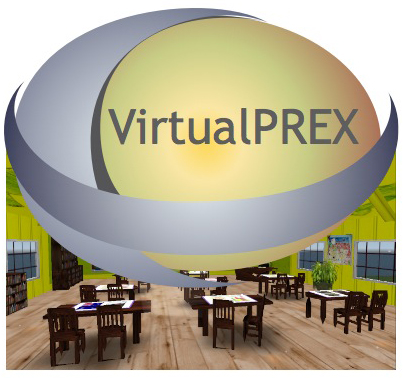
VirtualPREX
Virtual Professional Experience
Innovative assessment using a 3D virtual world with
pre-service teachers
VirtualPrex is a mechanism whereby pre-service teachers can gain skills, confidence and techniques to support their real life professional experience prior to practicum by the use of virtual worlds.
About the Project
Aims
Outcomes
Phases
How to use SL and VirtualPREX tools
VirtualPREX classrooms
VirtualPREX role-plays
Machinima
Assessment
Dissemination
Contacts - Project Team
Assessment using Machinima
Introduction
Use pre-existing
Construct own
Develop rubric
Annotate
Resources
References
Sponsored by:
 Support
for this
project has been provided by the Australian Learning and Teaching
Council Ltd, an initiative of the Australian Government Department of
Education, Employment and Workplace Relations.
The views expressed in this website do not necessarily reflect the
views of the Australian Learning and
Support
for this
project has been provided by the Australian Learning and Teaching
Council Ltd, an initiative of the Australian Government Department of
Education, Employment and Workplace Relations.
The views expressed in this website do not necessarily reflect the
views of the Australian Learning and Suggested assessment activities using machinima
3. Students to develop rubric against the AITSL standards
Instructions for teacher educators
The VirtualPREX website (http://www.virtualprex.com/machinima.html) contains example machinima that can be used for learning and assessment activities. When using machinima for assessment tasks the teacher educator can list the types of scenarios that are relevant for particular learning outcomes. For example, the pre-service teacher might be asked to look for examples of particular strategies that the teacher has used to engage students in the acquisition of knowledge and skills in a particular discipline; they may be asked to reflect on what were effective practices observed in the machinima or what appeared to be ineffective in engaging students and propose alternative strategies and practices. Observing machinima can be coupled with analysis and critique where the pre-service teacher can concentrate on aspects of behaviour management, examples of particular engagement strategies, communication skills (verbal, non-verbal, special awareness), how teachers might motivate students to stay on task.
Pre-service can be asked to analyse the machinima against the standards contained in the National Professional Standards for Teachers (http://www.teacherstandards.aitsl.edu.au/Standards). Using the standards, pre-service teachers can annotate the machinima or fill in a table identifying key activities or episodes that demonstrate evidence of meeting the standard. The pre-service teacher can also identify where the standards appear not to have been met.
Instructions for pre-service teachers
1. Using the machinima [insert machinima title and link], identify instances where the teacher demonstrated evidence of meeting [insert standard identifier] of the National Professional Standards for Teachers.
2. Using the machinima [insert machinima title and link], identify instances where the teacher did not demonstrate evidence of meeting [insert standard identifier] the National Professional Standards for Teachers. Propose how the standard could have been evidenced for this situation.
Key components for this activity:
1. View machinima first without taking any notes.
2. View machinima again, this time taking notes for selected instances of evidence for the aspects outlined in the rubric.
3. Provide an overall reflection on the approach adopted by the teacher to meeting [insert standard identifier] of the National Professional Standards for Teachers.
4. Your educator will provide feedback on your annotations and reflections.
Rubric for identifying activities that evidenced the AITSL National Professional Standards for Teachers in the chosen machinima:
| Domains of teaching |
Standards |
Observation of machinima |
| Professional Knowledge | PK1. Know students and how they learn |
|
| PK2. Know the content and how to teach it |
||
| Professional Practice | PP1. Plan for and implement effective teaching and learning |
|
| PP2. Create and maintain supportive and safe learning environments |
||
| PP3. Assess, provide feedback and report on student learning |
||
| Professional Engagement | PE1. Engage in professional learning |
|
| PE2. Engage professionally with colleagues, parents/ carers and the community |




